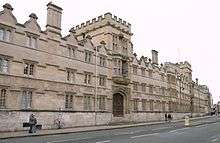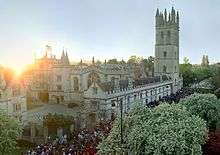High Street, Oxford
|
The High Street from St Mary's, looking east | |
| Other name(s) | The High |
|---|---|
| Location | Oxford, England |
| Postal code | OX1 |
| Coordinates | 51°45′09″N 1°15′07″W / 51.7525°N 1.252°WCoordinates: 51°45′09″N 1°15′07″W / 51.7525°N 1.252°W |
| East end | Magdalen Bridge |
| West end | Carfax |
| South | M |
| Other | |
| Known for | Oxford colleges and buildings |
_View_of_High_Street_Oxford_SFMOMA.jpg)





The High Street in Oxford, England, runs between Carfax, generally recognized as the centre of the city, and Magdalen Bridge to the east.[1]
Overview
The street has been described by Nikolaus Pevsner as "one of the world's great streets".[2] It forms a gentle curve and is the subject of many prints, paintings, photographs, etc. The vista looking west towards Carfax with University College on the left and The Queen's College on the right is an especially popular view. There are many historical buildings on the street, including the University of Oxford buildings and colleges.[3] Locally the street is often known as "The High".
Major buildings
To the north are (west to east): Lincoln College (main entrance on Turl Street, including All Saints Church, now Lincoln College's library.), Brasenose College (main entrance in Radcliffe Square), St Mary's (the University Church), All Souls College, The Queen's College, St Edmund Hall (main entrance in Queen's Lane) and Magdalen College (including Magdalen Tower).
To the south are (west to east): Oriel College, University College (including the Boyle-Hooke plaque outside the Shelley Memorial), the Examination Schools, the Ruskin School of Drawing and Fine Art, the Eastgate Hotel (at the original entrance to the city) and the Botanic Garden.
Commerce
Queen's Lane Coffee House (at the junction with Queen's Lane) was established in 1654 and was probably Oxford's first coffee house.
Despite an influx of chain stores in nearby Cornmarket Street, the High is home to a number of specialist independent retailers. These include Shepherd & Woodward (University outfitters), Payne & Son (goldsmiths), Sanders of Oxford (print sellers) and Waterfield's Books. To the north at the eastern end between Cornmarket and the Turl is the historic traditional Covered Market, established in 1774.
William Henry Butler, later Mayor of Oxford, was a wine merchant with premises in the High Street during the early 19th century.[4]
Edward Bracher, a pioneering Victorian photographer, had a shop at 26 High Street. Henry Taunt, another photographer, joined him as a member of staff in 1856. Taunt later returned to 41 High Street after the lease for his own shop premises in Broad Street expired in 1894.
83 High Street bears a blue plaque (10 October 2001) commemorating Sarah Cooper (1848–1932) marmalade maker, wife of Frank Cooper whose shop at 83–84 High Street was the origin of the Frank Cooper jam business (a brand now owned by Premier Foods). The company made "Oxford Marmalade" famous.
In June 1879, George Claridge Druce (also a noted botanist and later mayor of the city) moved to Oxford and set up a chemist's shop, Druce & Co., at 118 High Street. This continued until his death 1932.
The Old Bank Hotel was the first new hotel for 135 years in the centre of Oxford. Quod Brasserie is also part of the hotel, located between the junctions with Oriel Street and Logic Lane.
Commentary
The architectural critic Nikolaus Pevsner wrote in 1974 that
"The High Street is one of the world’s great streets. It has everything."[5][6]
He may have been echoing Thomas Hardy's comment in Jude the Obscure:
"And there's a street in the place — the main street — that ha'n't another like it in the world."[5][7]
Adjoining streets
The following streets, also of historical significance, are off the High Street:[1]
- Alfred Street
- Catte Street
- Cornmarket Street
- King Edward Street
- Logic Lane
- Longwall Street
- Magpie Lane
- Merton Street
- Oriel Street
- Queen Street
- Queen's Lane
- St Aldate's
- Turl Street
Gallery
 View down to buildings on the south side.
View down to buildings on the south side. View eastwards towards The Queen's College.
View eastwards towards The Queen's College. Students congregating in the High outside the Examination Schools.
Students congregating in the High outside the Examination Schools..jpg) All Saints Church, now Lincoln College's library.
All Saints Church, now Lincoln College's library. Lloyds Bank, at the far western end of High Street, at the Cornmarket Street intersection.
Lloyds Bank, at the far western end of High Street, at the Cornmarket Street intersection. Carfax, at the western end of the High Street.
Carfax, at the western end of the High Street. Magdalen College and the High Street on May Morning, 2007.
Magdalen College and the High Street on May Morning, 2007. The High Street, near the entrance to The Queen's College, looking east.
The High Street, near the entrance to The Queen's College, looking east.
 Big Issue magazine seller on the pavement in the High Street.
Big Issue magazine seller on the pavement in the High Street. Shops on the south side of the High Street near Carfax.
Shops on the south side of the High Street near Carfax. The High Street Oxford, as viewed from St Marys the Virgin Church, looking east.
The High Street Oxford, as viewed from St Marys the Virgin Church, looking east.

See also
- High Street, Oxford, an oil painting by J. M. W. Turner, exhibited in 1810
References
- 1 2 Sherwood, Jennifer; Pevsner, Nikolaus (1974). "The High Street and the Streets off the High Street". The Buildings of England: Oxfordshire. Penguin Books. pp. 306–311. ISBN 0-14-071045-0.
- ↑ Hibbert, Christopher, ed. (1988). "High Street". The Encyclopaedia of Oxford. Macmillan. pp. 183–185. ISBN 0-333-39917-X.
- ↑ Stephanie Jenkins, History of the High.
- ↑ William Henry Butler: Mayor of Oxford, January–October 1836, Mayors of Oxford.
- 1 2 Stephanie Jenkins, The High - Quotations
- ↑ Article on the street in the Oxford Mail
- ↑ Jude the Obscure in Google Books. The comment is made by a carter describing Christminster, Hardy's pseudonym for Oxford.
External links
| Wikimedia Commons has media related to High Street, Oxford. |
- The High, Oxford including tour and history
- Webcam from Carfax tower looking east down the High Street
- 360° QuickTime view from the top of Carfax Tower
- Oxford City Guide including list of shops on The High